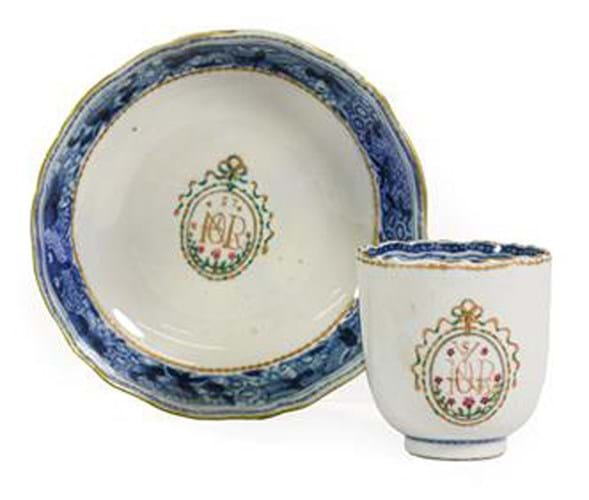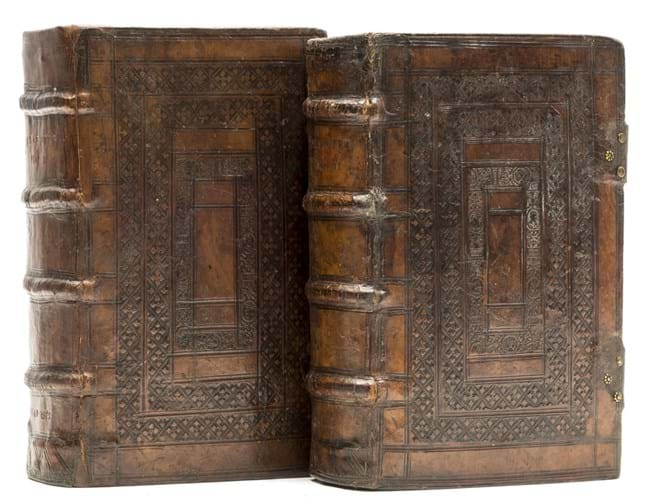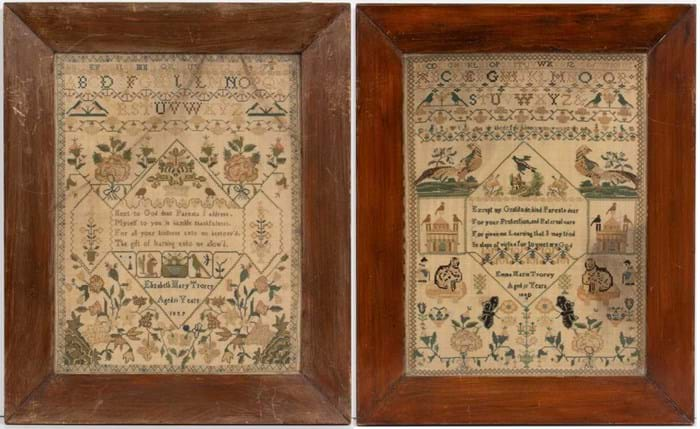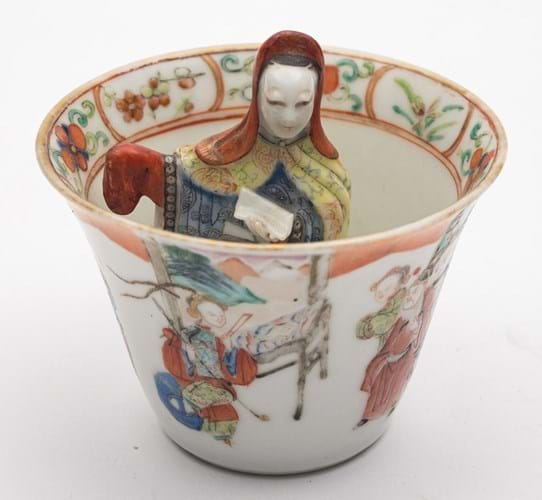1. Sir Joshua Reynolds’ coffee cup – £600
A pair of Chinese export coffee cups commissioned by portraitist Sir Joshua Reynolds (1723-1792) were included in Tennants’ Summer Fine Sale.
The cups and saucers are decorated with a monogram, almost certainly designed by Reynolds himself, which is constructed using all the letters in his name and title. Elements of the service c.1785 are noted in David Sanctuary Howard’s Chinese Armorial Porcelain (1974) together with an illustration of a tea caddy which is held in the collection of Dr Johnson’s House in the City of London.
The coffee cups hail from the private collection of the Aylmer family, who are descended from Reynolds’ elder sister, Mary Palmer (1716-1794). Sold separately at the auction on July 16-17, each had an estimate of £200-300 but they brought differing prices on account of condition. The better of the two sold at £600 while the other, with a broken an restored saucer, made £300.
Many wealthy families and individuals commissioned pieces in this way. Paintings or engravings of family crests were sent to China to be copied onto porcelain. From 1695 to 1820, some 4000 families are known to have imported crested services before the imposition of a hefty import tax made Chinese porcelain prohibitively expensive.
2. Terracotta vase by Magdalene Odundo – £94,000
Buoyed by the success of recent exhibitions at Hepworth Wakefield and Salon 94 in New York, pots by Kenyan born potter Dame Magdalene Odundo (b.1950) now enjoy the sort of financial rewards shared only by those of Hans Coper and Lucie Rie.
In November 2020, the London studio ceramics specialists Maak achieved a world record for a living ceramic artist with the sale of the 1988 Angled Mixed Coloured Piece. Selling at £200,000 it also became the second most expensive piece of British studio pottery next to a £305,000 cycladic form by Coper.
Two pieces by Odundo from a similar period featured at Lawrences sale in Crewkerne on July 19. A 13.5in (34cm) coil built burnished terracotta vessel combined a globular body with an oval shaped neck inspired by exaggerated African angular coiffeur. With the incised marks to base, Odundo, 1985, it was guided at a modest £5000-7000 but sold at £94,000.
From the same vendor was a smaller 9in (22cm) terracotta vase of globular form with a burnished and carbonised glaze from 1984. Guided at £3000-5000, it took £21,000.
3. Tudor legal statutes – £15,000
The sale at Forum Auctions in London on July 15 included, in its original binding, a two-volume work covering most of the statutes of Tudor England.
Printed between 1570-76, it was issued by Richard Tottel (c.1528-1594), the publisher and influential member of the legal community whose business was located at Temple Bar on Fleet Street. Although he is best known for the English poetry anthology Songes and Sonnets or Tottel’s Miscellany, the majority of Tottel’s printing was centred on legal documents.
In 1553 he was granted a much-coveted patent (later issued for life) that allowed him to print all authorised books dealing with the common law.
These statutes – one volume included the laws ’from the beginning of the raigne of Kyng Edwarde’, the other is a reissue of the Henry VIII statutes – provide an insight into the legal framework governing the lives and times of the Elizabethans. The laws include seismic matters such as Act of Supremacy and the Book of Common Prayer but also cover issues such as apparel, apprentices, bail, beggars, cathedrals, counterfeiting and so on.
The restored blind-stamped bindings appear to be by the enigmatic German-born ‘FD binder’ of which around 35 examples are known.
A rare survivor, it was guided at £4000-6000 but sold at £15,000.
4. Early Victorian samplers by two sisters – £7800
Samplers made by siblings or generations of the same family can attract a significant commercial premium. The House & Garden sale at Mallams Abingdon, Oxfordshire on July 19 included these two matching needleworks completed by Elizabeth Mary Trorey, aged 11 in 1839, and her younger sister Emma Marie Trorey, aged 11 in 1840.
Both girls display very considerable needlework skills working to the same size (56 x 45cm) and much the same format. Elizabeth chose a sophisticated design of roses and meandering flowers while, the following year, Emma Marie opted for a menagerie of pairs of cats, pheasants and butterflies. Both share the same framing making them very much a pair.
Undercooked at £200-300, they sparked plenty of interest ultimately selling at £7800.
5. Qing famille rose trick cup – £3100
Chinese trick or surprise cups such as this were made to deceive the heavy drinker and illustrate the classical paradigm that modesty brings gain and arrogance results in loss.
If you fill the cup to the top, taking more than your share, the liquid will drain onto your lap through a hole in the bottom. If you only fill the cup half full you can drink normally. The Chinese name Gong Dao Bei in Chinese means ‘don`t be greedy’ or ‘fairness’ cup.
The earliest cups of this type were made during the Song dynasty (960-1279) but most are from the mid to late Qing period. This example, probably 19th century, is decorated in famille rose enamels and centred by the figure of a sage.
Offered at Bearnes Hampton & Littlewood in Exeter on July 13 with a guide of just £50-80, it took £3100.










